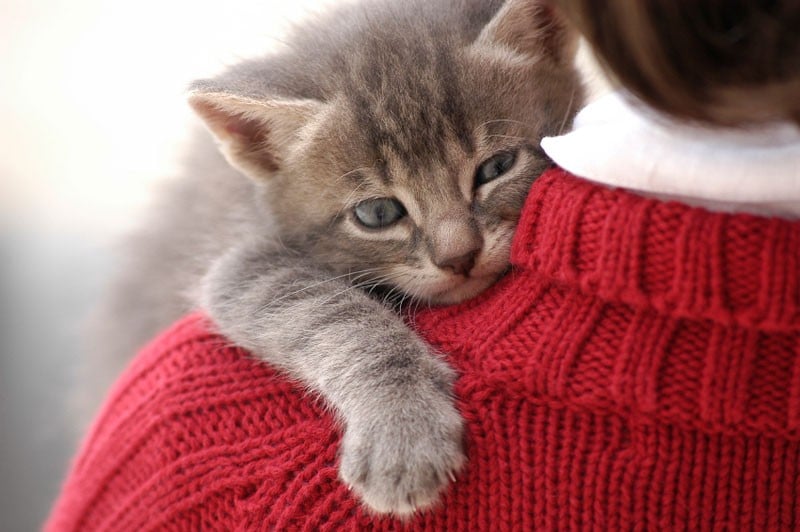
Spring is a stormy season. Here in Tennessee, flash floods, thunderstorms, and tornados are all too common. So having an emergency plan for your family, including your pets, is important. Just like Daylight Saving Time is a good reminder to change the batteries in your fire alarms, the start of spring is a great time to update your emergency plans.
Creating (Or Updating) Your Emergency Travel Kit
Having an emergency travel kit is important for everyone – whether you’re on your own with a single cat or dog or a family of four with pets in tow. The kit should be kept up-to-date and in a place that you can easily access it – whether that’s in a hall closet or in your go-to vehicle. What it contains is really up to you since everyone’s needs are a little different, but here are a few ideas:
- A sturdy carrier that can double as a bed – one for each pet
- Blanket and/or Evacsak
- A week’s worth of canned or dry food (Be sure to check the expiration dates yearly for canned food and monthly for dry food.)
- Bottled water for you and your pet (Replace every month.)
- Food and water dishes (Some carriers and crates have built-in spaces for these.)
- Your pet’s vaccination records and contact information for your veterinarian in a waterproof container
- A pet first-aid kit (You can buy these at any pet store or make your own.)
- A pet first-aid book (Even if you are a vet tech or have experience with pet emergency care, they’re always good to have in a pinch.)
- Collar with contact information and leash
- Toys
- Disposable litter trays (like Nature’s Miracle and Kitty’s Wonderbox)
- Baby wipes and pet-friendly cleaner
- Flashlights – at least two – and batteries
- Emergency radio
- Mobile Hotspot
- Extra cash
- First Aid kit (Some of the items in your pet’s kit can do double duty like gauze, hydro-peroxide, and rubbing alcohol.)
- Multi-tool or small tool kit
- Duct-tape (in a fluorescent color if possible)
- Waterproof boots, raincoat, and/or poncho
- Tarp (just in case) with rope
- Medical and insurance information
- Spare glasses, contacts (if you wear them)
- Medications (if you need them)
Have a Plan
Think about where you and your pets would go in case of emergency. Many shelters do not accept pets. So be sure to do a little pre-emergency research. Make a list of hotels that allow pets in your area and that are likely to remain open in an emergency situation. If you have multiple pets, this is especially important since some establishments only allow a single pet or pets up to a certain weight limit.
Some animal shelters also provide emergency shelter for pets, but they tend to fill up very quickly. Likewise, kennels that may shelter pets may not have emergency staff on hand – so plan on keeping your pets with you. If you are evacuating to a friend or neighbors’ home, be sure to let them know that you’ll have your pets in tow.
MicrochipYour Pets
If you haven’t already, please microchip your pets. Collars with ID and up-to-date contact information are important, but it’s easy for a pet and its collar to become separated in an emergency situation. GPS collars for pets are great – but only as long as they are on your pet.
Most microchip companies include a pet profile that will allow you to list your pet’s medical conditions, and, since all microchips now use the same frequency, any veterinarian will be able to identify your pet’s chip and contact you. If you do microchip, have the chip tested yearly during your pet’s annual check-up to make sure it is working correctly.
Have a Safe Haven In Your Home
Even if you aren’t evacuating, you may need to take shelter in your home during extreme storms. Be sure to move your pets into the “safety zone” well ahead of time – preferably during a storm watch instead of a storm warning. You’ll need to move your emergency kit, including food and water into that area, just in case you need it. Make sure you have at least seven days’ worth of water stored for you and your pets.
Basements, utility rooms, and bathrooms are good choices as safe havens. You want to choose a window-less room, below ground if possible in case of a tornado or other storm. In the case of flooding, choose the highest point in your home.
Since fresh water may be an issue, consider filling sinks and bathtubs with water before you move into your safety zone.
If your pets are frightened, you may want to keep them in their carriers/crates for the duration of the storm.
Stay Calm
During an emergency, your pet will be taking his or her cues from you. Having a plan and sticking to it will help you master the situation or at least roll with the punches. Hopefully, you’ll never need your emergency plan. But having one will give you and your pet peace of mind as we roll into the stormy season. Stay safe and have a great spring!



